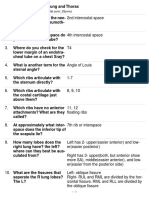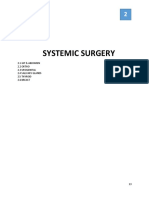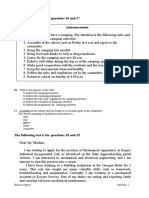0 ratings0% found this document useful (0 votes)
125 viewsCh. 10 Skin, Hair and Nails - Bickley and Bates
Ch. 10 Skin, Hair and Nails - Bickley and Bates
Uploaded by
fufuThis document summarizes the anatomy and physiology of skin, hair, and nails. It describes the layers of the epidermis and dermis, as well as structures like hair, nails, and glands. It also provides guidance on taking a history for skin conditions, including asking about lesions, rashes, itching, hair loss, and nail changes. Details are given on describing skin lesions based on features like size, color, and configuration. Finally, it outlines the stages of pressure injury from intact skin to full thickness tissue loss with exposed tissues beneath.
Copyright:
© All Rights Reserved
Available Formats
Download as DOCX, PDF, TXT or read online from Scribd
Ch. 10 Skin, Hair and Nails - Bickley and Bates
Ch. 10 Skin, Hair and Nails - Bickley and Bates
Uploaded by
fufu0 ratings0% found this document useful (0 votes)
125 views2 pagesThis document summarizes the anatomy and physiology of skin, hair, and nails. It describes the layers of the epidermis and dermis, as well as structures like hair, nails, and glands. It also provides guidance on taking a history for skin conditions, including asking about lesions, rashes, itching, hair loss, and nail changes. Details are given on describing skin lesions based on features like size, color, and configuration. Finally, it outlines the stages of pressure injury from intact skin to full thickness tissue loss with exposed tissues beneath.
Original Description:
Pathophysiology
Original Title
Ch. 10 Skin, Hair and Nails_Bickley and Bates
Copyright
© © All Rights Reserved
Available Formats
DOCX, PDF, TXT or read online from Scribd
Share this document
Did you find this document useful?
Is this content inappropriate?
This document summarizes the anatomy and physiology of skin, hair, and nails. It describes the layers of the epidermis and dermis, as well as structures like hair, nails, and glands. It also provides guidance on taking a history for skin conditions, including asking about lesions, rashes, itching, hair loss, and nail changes. Details are given on describing skin lesions based on features like size, color, and configuration. Finally, it outlines the stages of pressure injury from intact skin to full thickness tissue loss with exposed tissues beneath.
Copyright:
© All Rights Reserved
Available Formats
Download as DOCX, PDF, TXT or read online from Scribd
Download as docx, pdf, or txt
0 ratings0% found this document useful (0 votes)
125 views2 pagesCh. 10 Skin, Hair and Nails - Bickley and Bates
Ch. 10 Skin, Hair and Nails - Bickley and Bates
Uploaded by
fufuThis document summarizes the anatomy and physiology of skin, hair, and nails. It describes the layers of the epidermis and dermis, as well as structures like hair, nails, and glands. It also provides guidance on taking a history for skin conditions, including asking about lesions, rashes, itching, hair loss, and nail changes. Details are given on describing skin lesions based on features like size, color, and configuration. Finally, it outlines the stages of pressure injury from intact skin to full thickness tissue loss with exposed tissues beneath.
Copyright:
© All Rights Reserved
Available Formats
Download as DOCX, PDF, TXT or read online from Scribd
Download as docx, pdf, or txt
You are on page 1of 2
Ch.
10 Skin, Hair Nails (Bickley/Bate’s)
I. Anatomy and Physiology
a. Skin: epidermis, dermis, and subcutaneous tissue
b. Epidermis: thin vascular keratinized epithelium
i. Outer horny layer: stratum corneum: dead keratinized cells
ii. Inner cellular layer: stratum basale and the stratum
spinosum or Malpighian layer (melanin and keratin formed)
iii. Dermis: dense layer of interconnecting collagen and elastic
fibers containing epidermal appendages:
1. Pilosebaceous glands, sweat glands, follicles,
cutaneous nerves.
iv. Adipose tissue beneath: subcutaneous fatty tissue
v. Melanin: brownish pigment
vi. Oxyhemoglobin: bright red pigment in arteries
vii. Deoxyhemoglobin: darker bluer pigment in veins
c. Hair:
i. Vellus hair: short, fine, inconspicuous, unpigmented
ii. Terminal hair: coarser, thicker, conspicuous, pigmented
d. Nails:
i. Nail plate: rectangular and usually curving: pink
ii. Nail bed: vascular, plate is firmly attached
1. Lunula: whitish moon, free edge of the nail plate
2. Nail root: covered by the proximal nail fold
3. Cuticle is a seal, protects the space between the fold and the plate from external moisture
a. Angle between the proximal nail fold and the nail plate is less than 180 deg.
b. Fingernails grow 0.1 mm daily
e. Pilosebaceous glands: oil glands
i. Sweat glands:
1. Eccrine: widely distributed, open directly to the skin surface; help to control body temperature
2. Apocrine: found in axillary and genital region; usually open into hair follicles; responsible for body
order
II. Health Hx: General approach
a. Certain relevant aspects of skin disease processes such as duration, evolution, periodicity and prior episodes of
a similar type are often familiar to the patient; careful interview should be obtained.
b. Lesions: single layer of altered skin (look for lesions suggesting melanoma, basil cell carcinoma (BCC),
squamous cell carcinoma (SCC)
i. Ask about personal and family hx of lesions, sunscreen use, self-exam
c. Rashes and itching: widespread eruption of lesions
i. Ask about pruritus (most imp. s/s of rash)
ii. Allergies, itching at night, products; other accompanying s/s
iii. Causes of generalized itching, without apparent rash, include dry skin, pregnancy, uremia, jaundice,
lymphomas and leukemia, drug reactions and less commonly, polycythemia Vera and thyroid disease.
d. Hair loss and nail changes: Sudden, shedding thinning; from the root or shaft
i. Ask about product, shampooing.
ii. Common nail changes: onychomycosis, habit tic deformity, melanonychia
iii. Most common cause of diffuse hair thinning are male and female pattern baldness.
iv. Hair shedding at the roots is common in telogen effluvium and alopecia areata. Hair brakes along the shaft
suggest damage from her care or Tina capitis.
III. Describing skin lesions:
a. Number, size, color, shape, texture, primary lesion, location, and configuration.
i. Screening for Melanoma call using the ABCDE- EFG method
ii. Asymmetry; Border irregularity (ragged, notched or blurred); Color variation (blue-black, white
or red); Diameter > 6 mm; Evolving or changing rapidly in size, symptoms or morphology;
Elevation; Firmness to palpation and progressive Growing over several weeks.
1. Most sensitive is Evolution and is reliable for change.
b. Primary lesion: develop as direct result of, and therefore are most characteristic of the disease process.
c. Size: mm or cm
d. Number: single or multiple
e. Distribution: how skin lesions are scattered or spread out, random or patterned, symm or asymmm.
f. Configuration: linear or striate; annular/ring-like w/ central clearing; nummular or discoid (coin-shaped) no
central clearing; target or bull’s eye or iris; serpiginous or gyrate (having linear, branched and curving
elements)
g. Texture: smooth, fleshy, or rough, verrucous or warty, or scaly
h. Color
IV. Pressure injury staging:
a. Stage one: intact skin with a localized area a non-blanchable erythema, which may appear differently in darkly
pigmented skin
b. Stage two: partial thickness loss of skin with exposed dermis
c. Stage 3: full thickness skin loss, in which adipose/fat is visible in the ulcer and granulation tissue in rolled
wound edges, is often present
d. Stage 4: full thickness skin and tissue loss with exposed or directly palpable fascia, muscle, tendon, ligament,
cartilage, or bone in the ulcer
e. Unstageable: full thickness and tissue loss in which the extent of tissue damage within the answer cannot be
confirmed because it is obscured by sloth or eschar
f. Deep tissue pressure injury: persistent non blanchable deep red, maroon, or purple discoloration
You might also like
- Gua Sha Teacher Training Manual 04.06.2021Document150 pagesGua Sha Teacher Training Manual 04.06.2021ady.crocker1No ratings yet
- FA Mnemonics JSDocument7 pagesFA Mnemonics JSpiano543No ratings yet
- 1ST Term J1 Home EconomicsDocument22 pages1ST Term J1 Home EconomicsPeter Omovigho Dugbo100% (2)
- Diseases of Immune SystemDocument9 pagesDiseases of Immune SystemKhylle Camron LuzzieNo ratings yet
- Pgmee Test Series For Neet & Aiims: WWW - Aim4Aiims - In/Pg +91-7529938911Document24 pagesPgmee Test Series For Neet & Aiims: WWW - Aim4Aiims - In/Pg +91-7529938911Pravin MaratheNo ratings yet
- Neurology Study Guide Oral Board Exam ReviewDocument1 pageNeurology Study Guide Oral Board Exam Reviewxmc5505No ratings yet
- Block 13 Patho SlidesDocument62 pagesBlock 13 Patho SlidesLennon Ponta-oyNo ratings yet
- 3 Surgery - Mediastinum and PleuraDocument6 pages3 Surgery - Mediastinum and PleuraCassey Koi FarmNo ratings yet
- Cranial Nerves and BranchesDocument5 pagesCranial Nerves and Branchesballer0417No ratings yet
- Npath Trans08 Neoplasia PDFDocument13 pagesNpath Trans08 Neoplasia PDFAdrian CaballesNo ratings yet
- Surgery 2.01.1 Abdominal Wall - Dr. MendozaDocument5 pagesSurgery 2.01.1 Abdominal Wall - Dr. MendozaJorge De VeraNo ratings yet
- Minor SurgeryDocument6 pagesMinor SurgeryLove kumarNo ratings yet
- 149 First Aid CH 06 General Pathology FlashcardsDocument23 pages149 First Aid CH 06 General Pathology FlashcardsSomiZafarNo ratings yet
- IPD A Cardiovascular System Bates and and VideoDocument10 pagesIPD A Cardiovascular System Bates and and Videostar220498No ratings yet
- 120-Nr-M.D. Degree Examination - June, 2008-Pathology-Paper-IDocument16 pages120-Nr-M.D. Degree Examination - June, 2008-Pathology-Paper-IdubaisrinivasuluNo ratings yet
- Physio Ob ReviewDocument368 pagesPhysio Ob ReviewMark LopezNo ratings yet
- Small Intestine 01 PDFDocument9 pagesSmall Intestine 01 PDFfadoNo ratings yet
- Study Notes Respiratory SystemDocument19 pagesStudy Notes Respiratory SystemAnde Mangkuluhur Azhari ThalibbanNo ratings yet
- A.cranial Meninges, CSF, Blood Supply, Venous Drainage, BBBDocument7 pagesA.cranial Meninges, CSF, Blood Supply, Venous Drainage, BBBDr P N N Reddy100% (1)
- Git PathologyDocument113 pagesGit PathologyanggitaNo ratings yet
- Nematode Common Name Associated Disease Mode of Transmission Habitat Definitive Host Intermediate HostDocument5 pagesNematode Common Name Associated Disease Mode of Transmission Habitat Definitive Host Intermediate HostAnjelo PerenNo ratings yet
- CYSTSDocument20 pagesCYSTSSumaNo ratings yet
- Histology - Git Table 1Document1 pageHistology - Git Table 1lcrujidoNo ratings yet
- MBR 2019 - CNS Pathology HandoutDocument6 pagesMBR 2019 - CNS Pathology HandoutNica Lopez FernandezNo ratings yet
- RobbinsBasicPathologyCha Small00center10 492010Document3 pagesRobbinsBasicPathologyCha Small00center10 492010Tony DawaNo ratings yet
- Systemic Pathology ObjectivesDocument87 pagesSystemic Pathology ObjectivesroboonyaNo ratings yet
- Patho Common Stuff - RobbinsDocument7 pagesPatho Common Stuff - RobbinsMaf BNo ratings yet
- Pediatrics PerpetualDocument20 pagesPediatrics PerpetualHazel Fernandez VillarNo ratings yet
- Cancer Epidemiology and Pediatric Neoplasia p11-14Document4 pagesCancer Epidemiology and Pediatric Neoplasia p11-14zeroun24No ratings yet
- Systemic Pathology Study NotesDocument33 pagesSystemic Pathology Study NotesLaura BourqueNo ratings yet
- MicroDocument17 pagesMicroSuman MahmoodNo ratings yet
- Bates Chapter 8 Lung and ThoraxDocument15 pagesBates Chapter 8 Lung and ThoraxAdrian CaballesNo ratings yet
- Abdominal Trauma: Fatin Amirah KamaruddinDocument29 pagesAbdominal Trauma: Fatin Amirah Kamaruddinvirz23No ratings yet
- CSF & Body FluidDocument42 pagesCSF & Body FluidlopaNo ratings yet
- OSCE 2021 ReviewerDocument44 pagesOSCE 2021 ReviewerJulie100% (1)
- Carcinogenesis: Robbins Basic Pathology, 7 Kumar, Cotran, RobbinsDocument29 pagesCarcinogenesis: Robbins Basic Pathology, 7 Kumar, Cotran, RobbinslolimelatinaNo ratings yet
- MicroDocument11 pagesMicroSuman MahmoodNo ratings yet
- 2023 LabDx Trans03 Basic-Examinations-of-UrineDocument5 pages2023 LabDx Trans03 Basic-Examinations-of-UrinestellaNo ratings yet
- Cardiovascular Physical ExaminationDocument29 pagesCardiovascular Physical ExaminationannisNo ratings yet
- Anatomy Shelf NotesDocument200 pagesAnatomy Shelf NotesJad MitriNo ratings yet
- 1.1pathology B - Heart PDFDocument20 pages1.1pathology B - Heart PDFJulie SianquitaNo ratings yet
- Pathology SlidesDocument20 pagesPathology SlidesMrgNo ratings yet
- Endocrine Pathology p1-16Document16 pagesEndocrine Pathology p1-16zeroun24100% (1)
- IT 1 - Introduction To Anatomical PathologyDocument54 pagesIT 1 - Introduction To Anatomical Pathologyoptima fitraNo ratings yet
- Bate's Guide To Physical examination+MCQsDocument4 pagesBate's Guide To Physical examination+MCQsRaden Adjeng PalupiNo ratings yet
- UERM GROSS Cerebrum Cerebellum and CT ScanDocument82 pagesUERM GROSS Cerebrum Cerebellum and CT Scanroxanne.viriNo ratings yet
- OBSTETRICS - Midterms - 1.1 - Diagnosis of Pregnancy - TRANSDocument5 pagesOBSTETRICS - Midterms - 1.1 - Diagnosis of Pregnancy - TRANSAi Gutierrez100% (1)
- Basic Microbiology Board ReviewDocument248 pagesBasic Microbiology Board ReviewWilson James DoblasNo ratings yet
- Uworld Peds MicroDocument5 pagesUworld Peds MicroJoan ChoiNo ratings yet
- Grace Medicial Reviewer Delivery 1233Document3 pagesGrace Medicial Reviewer Delivery 1233Jacob SamsonNo ratings yet
- Divergent Differentiation, Creating So-Called Mixed Tumors: Seminoma Are Used For Malignant Neoplasms. TheseDocument6 pagesDivergent Differentiation, Creating So-Called Mixed Tumors: Seminoma Are Used For Malignant Neoplasms. TheseSherwin Kenneth Madayag100% (1)
- Robbins Ch. 19 The Pancreas Review QuestionsDocument3 pagesRobbins Ch. 19 The Pancreas Review QuestionsPA2014100% (1)
- Systemic Surgery NuggetsDocument17 pagesSystemic Surgery NuggetsAhmad UsmanNo ratings yet
- Pathology 1st Practical ExamDocument101 pagesPathology 1st Practical Examjeffrey_co_1No ratings yet
- CNS InfectionDocument10 pagesCNS InfectionShunqing ZhangNo ratings yet
- Pathology Slides by Organ 1-1Document36 pagesPathology Slides by Organ 1-1Lin AdutNo ratings yet
- GynecologyDocument3 pagesGynecologyShafaque IrfanNo ratings yet
- All in One Golden CPSP QuestionsDocument570 pagesAll in One Golden CPSP QuestionsQuranSunnat100% (2)
- Normal Histology of The Lung and Pathophysiology of COPD (T Year)Document36 pagesNormal Histology of The Lung and Pathophysiology of COPD (T Year)khaledalameddineNo ratings yet
- Problem-based Approach to Gastroenterology and HepatologyFrom EverandProblem-based Approach to Gastroenterology and HepatologyJohn N. PlevrisNo ratings yet
- Paget Disease of Bone, A Simple Guide to the Condition, Treatment and Related DiseasesFrom EverandPaget Disease of Bone, A Simple Guide to the Condition, Treatment and Related DiseasesNo ratings yet
- Unit # 06 Skin Management Insta Husain.z.kmuDocument43 pagesUnit # 06 Skin Management Insta Husain.z.kmuAamir IqbalNo ratings yet
- Shine Like A Star!: December 2023Document99 pagesShine Like A Star!: December 2023khatwanigunjan99No ratings yet
- Umbk Bahasa Inggris 2021Document13 pagesUmbk Bahasa Inggris 2021faruqiNo ratings yet
- Case Unpredictable DemandDocument3 pagesCase Unpredictable DemandnitishghuneNo ratings yet
- Pelangi Health & Physical Education P1 Chapter 1 Our BodyDocument48 pagesPelangi Health & Physical Education P1 Chapter 1 Our BodyCeman TudlasanNo ratings yet
- Classification and Management of Wounds: Warrington DivisionDocument2 pagesClassification and Management of Wounds: Warrington DivisionRoger ChristensenNo ratings yet
- Procedure Checklist Chapter 22: Bathing: Providing A Complete Bed BathDocument1 pageProcedure Checklist Chapter 22: Bathing: Providing A Complete Bed Bathmacs_smacNo ratings yet
- Assisting Diaper ChangeDocument4 pagesAssisting Diaper ChangebttinuhdizonNo ratings yet
- Beauty & Personal Care in Latin America: Category ReviewDocument62 pagesBeauty & Personal Care in Latin America: Category ReviewGlory MendozaNo ratings yet
- Conceptual FrameworkDocument5 pagesConceptual FrameworkJena AnaretaNo ratings yet
- The Following Text Is For Questions 16 and 17Document12 pagesThe Following Text Is For Questions 16 and 17sman1 kayuagungNo ratings yet
- Fetal Pig Dissection Lab Report PDFDocument4 pagesFetal Pig Dissection Lab Report PDFrqzmzbqsxwNo ratings yet
- Ibeautypen® 3 User ManualDocument14 pagesIbeautypen® 3 User ManualPaulo OliveiraNo ratings yet
- Color Atlas and Synopsis of Pediatric Dermatology (PDFDrive)Document375 pagesColor Atlas and Synopsis of Pediatric Dermatology (PDFDrive)Madalina Nastase100% (1)
- Skin ConditionsDocument3 pagesSkin ConditionsAlyssa AmayaNo ratings yet
- Vulvovaginal LesionsDocument100 pagesVulvovaginal LesionsEmaan NoorNo ratings yet
- Facial Vascular Danger Zones For Filler Injections: Uwe Wollina - Alberto GoldmanDocument8 pagesFacial Vascular Danger Zones For Filler Injections: Uwe Wollina - Alberto GoldmanLuis Fernando WeffortNo ratings yet
- Suture PatternsDocument24 pagesSuture Patternsloverpes604No ratings yet
- Kamedis Business Development BrochureDocument8 pagesKamedis Business Development Brochurepanji respatiNo ratings yet
- Sutures: Dr. Oyebode OyeyiolaDocument50 pagesSutures: Dr. Oyebode Oyeyiolaoyebode oyeyiolaNo ratings yet
- QUESTIONNAIREDocument2 pagesQUESTIONNAIRETmanoj PraveenNo ratings yet
- Medical-Surgical Nursing 1: Pamantasan NG Lungsod NG MaynilaDocument3 pagesMedical-Surgical Nursing 1: Pamantasan NG Lungsod NG MaynilaAye DumpNo ratings yet
- TBT-03 Finger Injury Week-2Document3 pagesTBT-03 Finger Injury Week-2saad aliNo ratings yet
- Laser Hair Removal GuidelinesDocument28 pagesLaser Hair Removal GuidelinesMIKE100% (1)
- HookwormDocument5 pagesHookwormImee Jen AbadianoNo ratings yet
- Case Report Clinical Experience With FRAC3 Non-Ablative Skin TighteningDocument4 pagesCase Report Clinical Experience With FRAC3 Non-Ablative Skin TighteningPhúc LâmNo ratings yet
- GroomingAssignment CompletedDocument5 pagesGroomingAssignment CompletedAditya giriNo ratings yet
- Perform Styling Techniques: Evidence GuideDocument7 pagesPerform Styling Techniques: Evidence GuideShahid HanifNo ratings yet

























































































